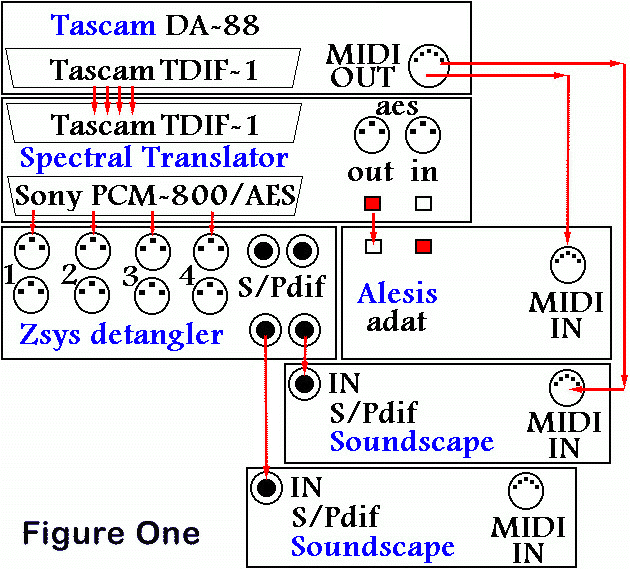
Reviewed 2 October'96
by Eddie Ciletti
( Review should appear in the AES issue of EQ )
MANUFACTURER: Spectral (a Euphonix Company), 18800 142nd Ave NE, Woodinville, WA 98072, Tel: 206-487-2931.
APPLICATION: Digital audio format converter.
SUMMARY: Converts the following proprietary digital formats: Alesis, Sony, Spectral, Tascam and Yamaha.
STRENGTHS: Very easy-to-use, no manual required. The Translator Plus selects and routes signals like a digital patchbay.
WEAKNESSES: No AES channel selector.
PRICE: Translator, $995 (w/o AES ports); Translator Plus, $1,495.00 (w/AES ports)
ABOUT SPECTRAL
Spectral is an American workstation company (owned by Euphonix) whose interface experience comes naturally. Their two hardware packages — the Audio Engine (16 channels from $3,900 - $12,000) and the Prisma (8 channels from $3400 - $6800) — are supported by Express, Producer and Studio Tracks software. The Translator and the Translator Plus (reviewed here) are two, single-rack space products that were created to make your interconnecting life easier.
A WACKY IDEA
About a bazillion years ago I recorded a band-in-a-barn in a little town called Bearsville, NY. Now that I have a workstation, a wacky idea to remix those old tunes has taken root. The scary part is that analog tapes of this vintage suffer from major shedding — the binder that secures the precious oxide to the plastic backing absorbs moisture and is deactivated. Baking re-activated the binder long enough to transfer twenty-four very raw tracks to three DA-88s.
The Problem: How to get twenty-four tracks into a digital workstation that only records two tracks at a time without leaving the digital domain?
The Solution: The Spectral Translator Plus (with a little help from Z-system’s Digital Detangler).
A PRETTY FACE
On the surface, the Translator is a user-friendly 5x5 digital patchbay. (I misplaced the manual but still managed to get the job done!) Two identical rows, labeled Format A and Format B, have five buttons each, which in turn are labeled: ODI (ADAT optical); SMDAI (Spectral); TDIF (Tascam); Y2 (Yamaha); and standard AES. Each position has its own very bright LED to clearly indicate the selection. Three Master Clock options — Format A (the source), AES and Internal — plus six LEDs indicate the selected clock, the Sample Rate (44.1kHz or 48 kHz) and System Lock, all respectively. Choosing the same source and destination lights a Bypass LED, while the AES output can choose between Format A and Format B. There are two additional outputs: Word Clock and Super Clock.
BLOCK (HEAD) DIAGRAM
Figure One shows a block diagram of the Translator interfaced to a DA-88, a Z-Systems Digital Detangler, a pair of Soundscape SSHDR-1 workstations as well as an Alesis ADAT. The Source (Format A) is the DA-88. From a single DB-25 connector, Tascam’s proprietary Digital Interface (TDIF-1) has four, unbalanced stereo inputs and outputs. For the Destination (Format B), I chose the Sony PCM-800 format which is also on a DB-25. Inputs and output are on separate DB-25 connectors and the format is actually four standard AES signals.

Spectral supplied a pair of DB-25 to XLR harnesses, one of which linked The Translator to the Z-Systems z-8.8 detangler. I chose this method because the AES ports of the Translator are hard-wired to channels 1 and 2. The z-8.8 has four AES inputs which were then independently routed to each Soundscape unit, allowing four channels to be transferred at once. MIDI time code between the DA-88 and the SSHDR-1 completed the picture.
I also did a quick eight-channel transfer between a DA-88 and an ADAT. Again the transfer was painless. It made me think that maybe there might be a niche business in digital transfers....
BLENDING ECSTASY: A DREAM COME TRUE
I love workstation mixing for its editing power and automation. Edison was right, "Genius is one-percent inspiration and ninety-nine percent perspiration." So much for the raw tracks. At least the Spectral Translator allowed me to stay in the digital domain and make the job simple, painless and transparent.
Now I need an equally affordable, platform independent and/or stand-alone DSP that will run anyone's software...